EssaysSISTER BERNADETTE’S BARKING DOG Diagramming sentences is one of those lost skills, like darning socks or playing the sackbut, that no one seems to miss. Invented, or at least codified, in an 1877 text called Higher Lessons in English by Alonzo Reed and Brainerd Kellogg, it swept through American public schools like a measles germ, embraced by teachers as the way to reform students who were engaged in (to take Henry Higgins slightly out of context) “the cold-blooded murder of the English tongue.” By promoting the beautifully logical rules of syntax, diagramming would root out evils like “it’s me” and “I ain’t got none,” until everyone wrote like Ralph Waldo Emerson, or at least James Fenimore Cooper. Even in my own youth, many years after 1877, diagramming was serious business. I learned it in the sixth grade from Sister Bernadette. I can still see her: a tiny nun with a sharp pink nose, confidently drawing a dead-straight horizontal line like a highway across the blackboard, flourishing her chalk in the air at the end of it, her veil flipping out behind her as she turned back to the class. We begin, she said, with a straight line. And then, in her firm and saintly script, she put words on the line, a noun and a verb – probably something like dog barked. Between the words she drew a short vertical slash, bisecting the line. Then she made a road that forked off at an angle – a short country lane under the word dog – and on it she wrote The. That was it: subject, predicate, and the
little modifying article that civilized the sentence – all of it made
into a picture that was every bit as clear and informative as an actual
portrait of a beagle in mid-woof. The thrilling part was that this was
a picture not of the animal but of the words that stood for the animal
and its noises. It was a representation of something that was both
concrete (we could hear the words if we said them aloud, and they
conveyed an actual event) and abstract (the words were invisible, and
their sounds vanished from the air as soon as they were uttered). The
diagram was the bridge between a dog and the description of a dog. It
was a bit like art, a bit like mathematics. It was much more than words
uttered, or words written on a piece of paper: it was a picture of
language. I was hooked. So, it seems, were many of my contemporaries. Among the myths that have attached themselves to memories of being educated in the Fifties is the notion that activities like diagramming sentences (along with memorizing poems and adding long columns of figures without a calculator) were draggy and monotonous. I thought diagramming was fun, and most of my friends who were subjected to it look back with varying degrees of delight. Some of us were better at it than others, but it was considered a kind of treat, a game that broke up the school day. You took a sentence, threw it against the wall, picked up the pieces, and put them together again, slotting each word into its pigeonhole. When you got it right, you made order and sense out of what we used all the time and took for granted: sentences. Gertrude Stein, of all people, claimed to be a fan of diagramming. “I really do not know that anything has ever been more exciting than diagramming sentences,” she wrote in the early 1930s. “I like the feeling the everlasting feeling of sentences as they diagram themselves.” Well, in my experience they didn’t exactly diagram themselves; they had to be coaxed, if not wrestled. But – the feeling the everlasting feeling: if Gertrude Stein wasn’t just riffing on the words, the love-song sound of them, she must have meant the glorious definiteness of the process, the way something as ephemeral as words didn’t fade away in the air but became chiseled in stone – yes, this is a sentence, this is what it’s made of, this is what it looks like, a chunk of English you can see and grab onto. I remember loving the look of the sentences, short or long, once they were tidied into diagrams – the curious geometric shapes they made, their maplike tentacles, the way the words settled primly along their horizontals like houses on a road, the way some roads were culs de sac and some were long meandering interstates with many exit ramps and scenic lookouts. And the perfection of it all, the ease with which – once they were laid open, all their secrets exposed – those sentences could be comprehended. On a more trivial, pre-teen level, part of the fun was being summoned to the blackboard to show off your skills. There you’d be with your chalk while, with a glint in her eye, Sister Bernadette read off an especially tricky sentence. Compact, fastidious handwriting was an asset. A good spatial sense helped you arrange things so that the diagram didn’t end up jammed against the edge of the blackboard like commuters in a subway car. The trick was to think fast, write fast, and try not to get rattled if you failed nobly in the attempt. As we became more proficient, the tasks got harder. There was great appeal in the Shaker-like simplicity of sentences like The dog chased a rabbit (subject, predicate, direct object) with their plain, no-nonsense diagrams:  But there were also lovable subtleties,
like the way the line that set off a predicate adjective slanted back
toward the subject it referred to, like a signpost or a pointing finger:  Or the thorny rosebush created by diagramming a prepositional phrase modifying another prepositional phrase: 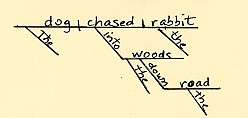 Or the elegant absence of the preposition when using an indirect object, indicated by a short road with no house on it: 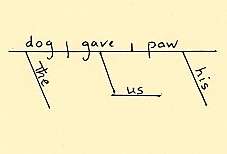 The missing preposition – in this case to
– could also be indicated by placing it on that road with parentheses
around it, but this always seemed to me a clumsy solution, right up
there with explaining a pun. In a related situation, however, the void
where the subject of an imperative sentence would go is better filled –
in my opinion then and now – with the graphic and slightly menacing
parenthesized pronoun, as in:  Questions were a special case: for
diagramming, they had to be turned inside out, the way a sock has to be
eased onto a foot: What is the dog doing? transformed into the more
dramatic: The dog is doing what?  Mostly we diagrammed sentences out of a
grammar book, but sometimes we were assigned the task of making up our
own, taking pleasure in coming up with wild Proustian wanderings that –
kicking and screaming – had to be corralled, harnessed, and made to
trot in neat rows into the barn. 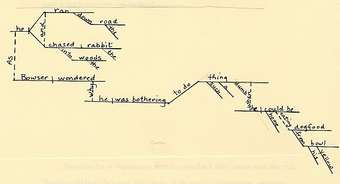 Part of the fun of diagramming sentences
was that it didn’t matter what they said. The dog could bark, chew gum,
play chess – in the world of diagramming, sentences weren’t about
meaning so much as they were about subject, predicate, object, and
their various dependents or modifiers. But if they were diagrammed
properly, they always illustrated correct syntax, no matter how silly
their content. We hung those sentences out like a wash, wrote them out
like lines of music, arranged them on a connecting web of veins and
arteries until we understood every piece of them. We could see for
ourselves the difference between who and whom. We knew what an adverb
was, and we knew where in a sentence it went, and why it went there. We
were aware of dangling modifiers because we could see them, quite
literally, dangle. And we knew that gerunds looked like verbs but were
really nouns because they could take a direct object: 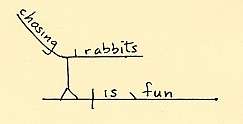 Today, diagramming is not exactly dead,
but for many years it has been on a steep slide into marginality. This
is probably partly because diagramming sentences doubles the task of
the student, who has to learn a whole new set of rules – where does
that pesky line go, and which way does it slant? – in order to
illustrate a set of rules that, in fact, has already been learned
pretty thoroughly simply by immersion in the language from birth. It’s
only the subtleties that are difficult – who vs. whom, adjective vs. adverb, it’s I vs. it’s me
– and most of those come from the mostly doomed attempt, so beloved in
the early days of English grammar, to stuff the unruliness of English
into the well-made boxes of Latin and Greek, which is something like
forcing a struggling cat into the carrier for a trip to the vet. Another problem is that teachers – and certainly students – have become more willing to accept the idea that the sentences that can be popped into a diagram aren’t always sentences anyone wants to write. One writer friend of mine says that she disliked diagramming because it meant “forcing sentences into conformity.” And indeed language can be more supple and interesting than the patterns that perfect syntax forces on it. An attempt to diagram a sentence by James Joyce, or one by Henry James (whose style H. G. Wells described so memorably by as that of “a magnificent but painful hippopotamus resolved at any cost upon picking up a pea”), will quickly demonstrate the limitations of Sister Bernadette’s neatly bundled sentences. Diagramming may have taught us to write more correctly – maybe even to think more logically – but I don’t think anyone would claim that it taught us to write well. Soon after I got to college, one of my English professors spent an hour kindly explaining how I could make my writing less stiff and pompous – an hour that I can honestly say changed my life – and the years have shown me that Virginia Woolf’s comment on the subject is the simple truth: “Style is a very simple matter: all rhythm. Once you get that you can’t use the wrong words.” And besides, any writer knows that the best way to learn to write good sentences has always been not to diagram them but to read them. Still, like pocket watches and Gilbert & Sullivan operas, diagramming persists, alternately trashed and cheered by linguists and grammarians. It can be found in university linguistics courses and on the web sites of a few diehard enthusiasts. There are teacher guides, should any teacher want one; it’s taught in ESL courses with some frequency, and in progressive private schools. There’s a video available called English Grammar: The Art of Diagramming Sentences that features a very 1950s-looking teacher named Miss Lamb working at a blackboard. There’s even a computer program, apparently, that diagrams. Sometimes, on a slow subway or a boring car trip, I mentally diagram a sentence, just as I occasionally try to remember the declension of hic, haec, hoc or the words to the second verse of The Star-Spangled Banner. I have no illusions about what diagramming sentences in my youth did for me in any practical way. But, in an occasional fit of nostalgia and creeping curmudgeonhood, I like bringing back those golden afternoons when 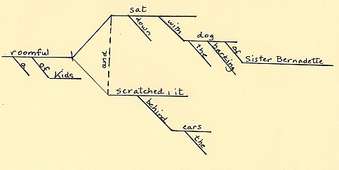 |